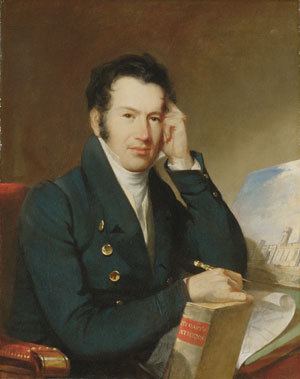Name John Haviland | Role Architect | |
 | ||
Died March 28, 1852, Philadelphia, Pennsylvania, United States Structures Eastern State Penitentiary, Franklin Institute, Walnut Street Theatre, Philadelphia History Museum, Essex County Jail Similar People William Strickland, Frank Furness, Willis G Hale, Cesare Beccaria, John Quincy Adams | ||
John Haviland (15 December 1792 – 28 March 1852) was an English-born architect who was a major figure in American Neo-Classical architecture, and one of the most notable architects working from Philadelphia in the 19th century.
Contents
Biography
Born 15 December 1792, at Gundenham, near Taunton, Somerset, England, Haviland was apprenticed in 1811 to a London architect. In 1815 he unsuccessfully pursued an appointment to the Russian Imperial Corps of Engineers. In Russia, however, he met George von Sonntag and John Quincy Adams, who encouraged him to work in the United States. He arrived in Philadelphia in 1816, and soon established himself as one of the few professional architects in the city.
By 1818, Haviland produced a book, The Builder's Assistant, which appeared in three volumes over several years. This publication was one of the earliest architectural pattern books written and published in North America, and likely the first to include Greek and Roman classical orders.
In part due to The Builder's Assistant, Haviland began to secure what would be his most important commissions in Philadelphia: the Eastern State Penitentiary, the Pennsylvania Institution for the Deaf and Dumb (now Dorrance Hamilton Hall, University of the Arts), and the original Franklin Institute building (now home to the Atwater Kent Museum).
During this time, Haviland unwisely speculated in his own projects, including commercial arcades in Philadelphia and New York, as well as an amusement park. He was eventually forced into bankruptcy, tarnishing his professional reputation in Philadelphia. Elsewhere, however, Haviland's reputation as a designer of prisons brought him important commissions, including the New Jersey Penitentiary, The Tombs in New York City, and prisons in Missouri, Rhode Island, and Arkansas.
Haviland was an Honorary and Corresponding Member of the Royal Institute of British Architects. In 1827, he was elected into the National Academy of Design as an Honorary Academician.
Personal life
On July 2, 1819, Haviland was married to Mary Wright von Sonntag by the Right Rev. William White, Bishop of Pennsylvania. She was the sister of George von Sonntag and the daughter of Captain William Ludwig von Sonntag of the French Army. Together, they had a son:
He died March 28, 1852 in Philadelphia and was buried in the family vault at St. Andrews Church (designed by Haviland) in Philadelphia (now the Greek Orthodox Cathedral of St. George).
